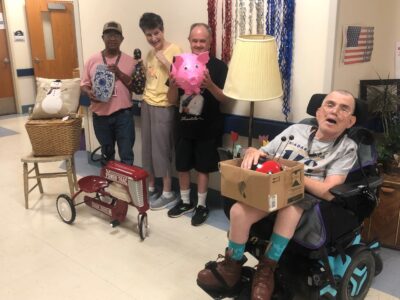Fenton Director Address Jamestown Rotary Club

From left are Joni Blackman, and Marion Beckerink, past president of the Rotary Club of Jamestown.
Forty years of learning in the real world has provided many of the skills needed to manage a small local history museum.
Joni Blackman has served as an officer and director for several local non-profit boards over the past 30 years. She has attended many professional development seminars, annual meetings and workshops by the American Association of Museums, the Western N.Y. Library Resources Council, and regional agencies.
Blackman shared general details about the Fenton History Center and Fenton Mansion. She explained that the Fenton involves a tight group of supporters, with more than 400 members. The annual budget is $250,000 and includes a staff that includes one full-time worker (her position) and three part-time workers, along with more than 90 volunteers.
The home of the history center is the Fenton Mansion, built in 1863 by former governor and U.S. Senator Reuben E. Fenton, a native of Chautauqua County who became a prominent lumberman and businessman in Jamestown before entering politics. The center is 12,000 square-feet and contains 25 rooms, 19 of which are used as exhibit space. The History Center also has a second building, the Fenton Research Center, which is older than the mansion and was built in 1846. The research center houses all the documents, books, and research material that is crucial in helping to preserve our local history. There is also an off-site storage location for much larger items, including everything from furniture, pianos, soap box derby cars, and more. Blackman indicated the Fenton is looking for a third building to display items, including the trolley car that has been restored by Bob Johnston.
The Fenton has numerous exhibits on display, including the most recent exhibit focusing on Jamestown’s early history. It is called “From the Rapids” and the name is specific to the time period when the Chadakoin River was simply known as The Rapids, due to the river having many rapids as the water was discharged from the Chautauqua Lake outlet. This period is when James Prendergast first came here to establish sawmills for his lumber enterprise. Joni provided a brief history of the Prendergast family and how it initially came through the area from eastern New York State, on their way to Tennessee. However, the Tennessee political climate didn’t sit well with the family, and they eventually returned to the Chautauqua Region.
This is when James Prendergast, as the story goes, had a team of horses run loose, and he went out searching for them. As he looked for them, he came upon The Rapids and determined it would be perfect to use the waterpower to establish his lumber business. The new exhibit features several key items, including a silver ladle that was made from the melted silver that was found following the Prendergast house fire of 1812. It also contains linen sheets that were made by James’ wife in 1816. Another new exhibit focuses on the 1945 tornado that struck Jamestown and, more specifically, Brooklyn Square and Harrison Street, causing over $50 million in damages.
Besides exhibits, the Fenton also offers extensive programs and lectures, recurring genealogy workshops, a veterans finding veterans program, and the popular “Saints and Sinners” Cemetery tours in the fall. Joni also noted that the Fenton is collaborating with several other history groups to hold a Chautauqua County History Expo near the end of August.






